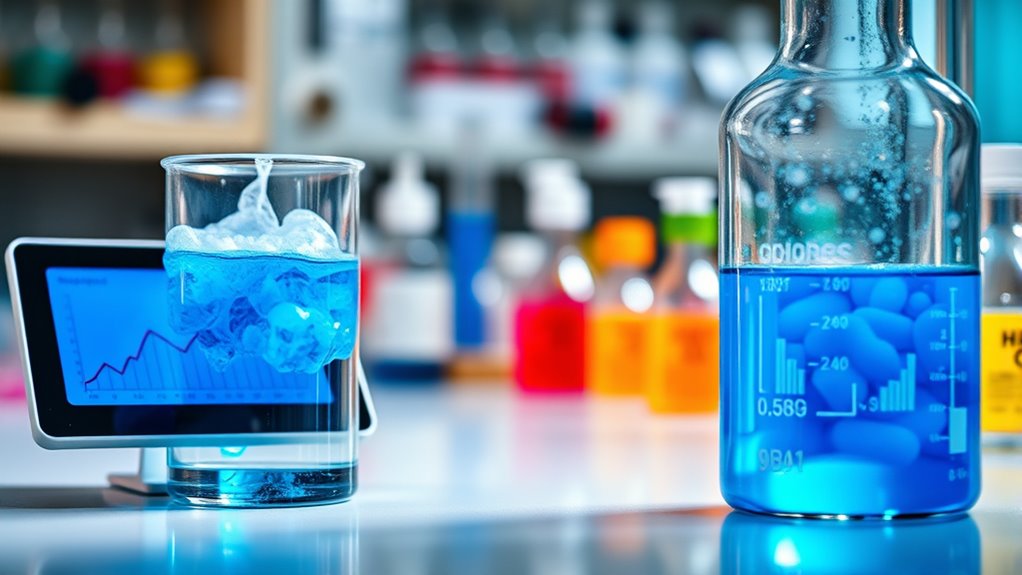Gibbs free energy helps you predict if a reaction will happen on its own. If the Gibbs free energy change (ΔG) is negative, the reaction occurs spontaneously, releasing energy. Factors like temperature, heat, and disorder influence ΔG. A reaction’s spontaneity depends on the balance between energy absorbed or released (enthalpy) and the system’s disorder (entropy). To understand how these ideas connect and their real-world uses, there’s more to explore.
Key Takeaways
- Negative Gibbs free energy (ΔG) means a reaction occurs spontaneously and releases energy.
- The formula ΔG = ΔH – TΔS shows how heat change (ΔH) and disorder (ΔS) influence spontaneity.
- If ΔH is negative and ΔS is positive, the reaction is more likely to be spontaneous at various temperatures.
- Increasing temperature favors reactions with positive ΔS, making them more spontaneous.
- When ΔG equals zero, the system is at equilibrium, with no net reaction happening.
What Is Gibbs Free Energy and Why Is It Important?
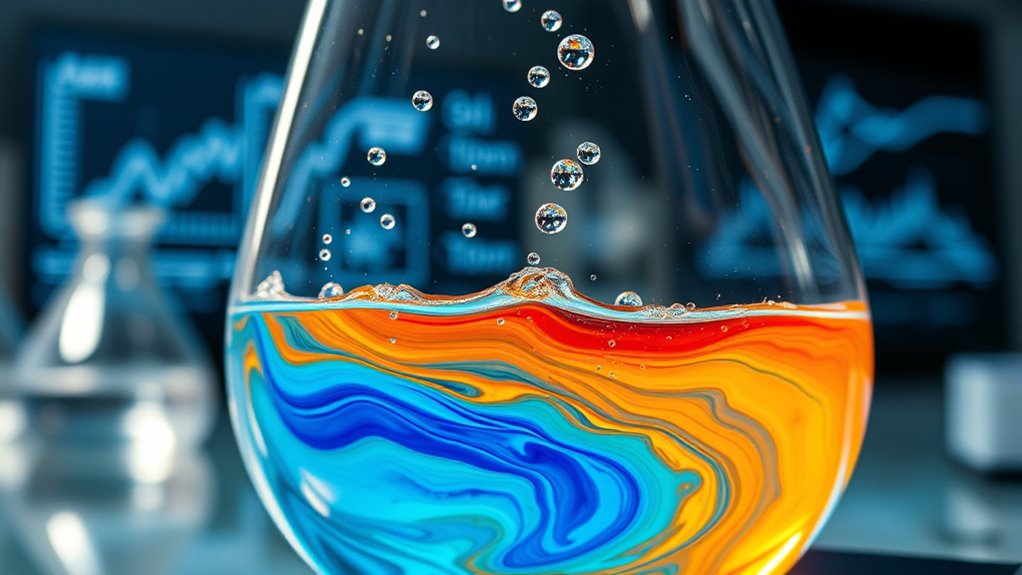
Have you ever wondered how scientists determine if a chemical reaction will happen spontaneously? That’s where Gibbs free energy comes in. It’s a thermodynamic potential, represented by ‘G’, that tells you whether a reaction will proceed on its own under constant pressure and temperature. The change in Gibbs free energy (Delta G) is calculated as (Delta H – TDelta S), balancing enthalpy (heat content) and entropy (disorder). If (Delta G) is negative, the reaction is spontaneous, releasing useful energy. Developed by Josiah Gibbs in the 1870s, it’s essential for predicting equilibrium, understanding biological processes, and guiding industrial reactions. Understanding thermodynamic potentials enhances our ability to predict reaction behavior accurately. Additionally, Gibbs free energy is crucial in fields like chemical engineering for optimizing reaction conditions and improving efficiency. Recognizing the relationship between energy and spontaneity helps scientists design more sustainable and cost-effective processes.
How Gibbs Free Energy Indicates Reaction Spontaneity
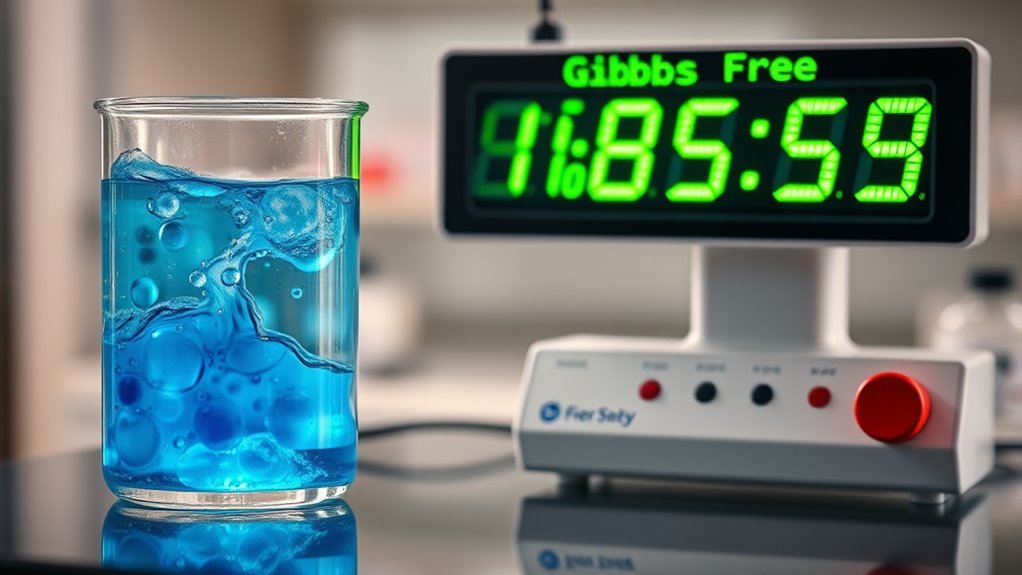
Gibbs free energy provides a clear way to determine whether a chemical reaction will occur spontaneously. When ΔG is negative, the reaction proceeds on its own, without external help. If ΔG is positive, the reaction won’t happen spontaneously and needs energy input.
Temperature and entropy changes influence ΔG, with higher temperatures amplifying the role of entropy. Negative ΔH (exothermic reactions) and positive ΔS (increased disorder) always make ΔG negative, ensuring spontaneity regardless of temperature. Additionally, understanding the impact of temperature and entropy can help in designing more efficient reactions and processes.
Higher temperatures increase the impact of entropy, promoting spontaneity when ΔH is negative and ΔS positive.
Furthermore, the relationship between enthalpy and entropy is crucial in predicting reaction outcomes, especially when ΔH and ΔS have opposing signs. Conversely, positive ΔH and negative ΔS tend to produce positive ΔG, making reactions non-spontaneous. By calculating ΔG, you can predict whether a reaction is likely to happen naturally.
Additionally, understanding the limits and constraints can help in designing more efficient reactions and processes.
When ΔG equals zero, the system is at equilibrium, with no net change occurring.
The Formula Behind Gibbs Free Energy and Its Meaning

Understanding the formula behind Gibbs Free Energy is essential for predicting whether a reaction will occur spontaneously. The key equation is (Delta G = Delta H – T Delta S).
Here, (Delta H) measures the heat energy change, while (Delta S) reflects the change in disorder or randomness. Temperature ((T)) influences how entropy affects spontaneity. Environmental impact considerations, such as Leave No Trace principles, are also important when applying these concepts to real-world situations. Recognizing how relationships can be affected by underlying factors can help in understanding the conditions that favor spontaneity.
A negative (Delta G) means the reaction is thermodynamically favorable and can occur spontaneously.
When substances are in their standard states, we use (Delta G^circ), which helps compare different reactions under consistent conditions.
The balance between enthalpy and entropy, adjusted by temperature, determines if a process is spontaneous.
Understanding the Role of Enthalpy and Entropy in Reactions
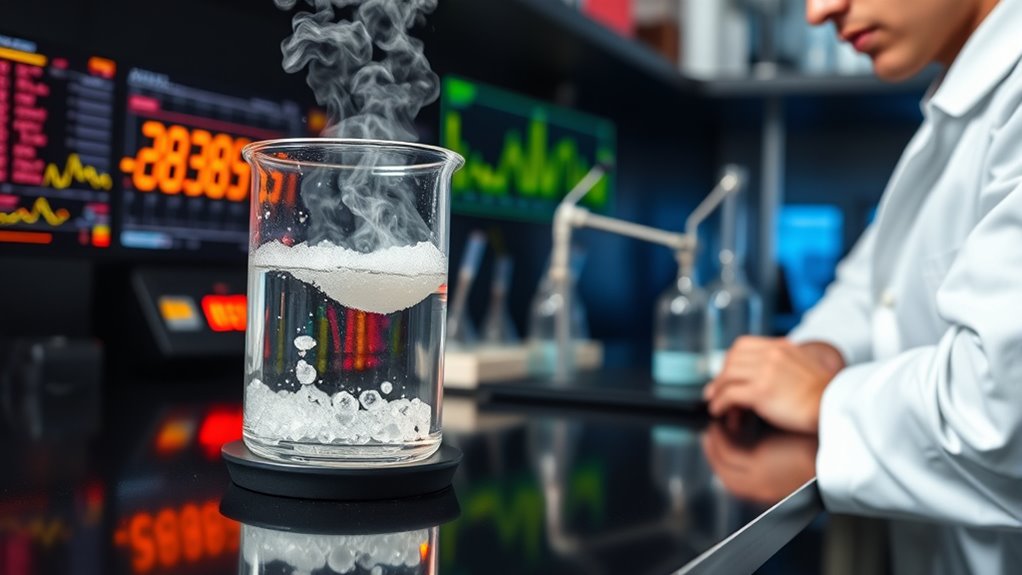
Enthalpy and entropy are fundamental concepts that determine whether a chemical reaction occurs spontaneously. Enthalpy (H) measures the total energy in a system, including internal energy and pressure-volume work. A negative ΔH indicates an exothermic reaction, releasing energy, while a positive ΔH signifies an endothermic process, absorbing energy. Urban pursuits in Harrisburg often highlight the importance of understanding chemical processes in urban environments, such as pollution control and energy efficiency.
Entropy (S) reflects the system’s disorder; a positive ΔS means increased randomness, which favors spontaneity. Both ΔH and ΔS influence Gibbs free energy (ΔG), where a negative ΔG signals a spontaneous reaction.
If ΔH is negative or ΔS is positive, the reaction is more likely to happen spontaneously. These factors work together, with temperature playing a key role, to determine whether a reaction will proceed on its own.
How Conditions Like Temperature Affect Gibbs Free Energy
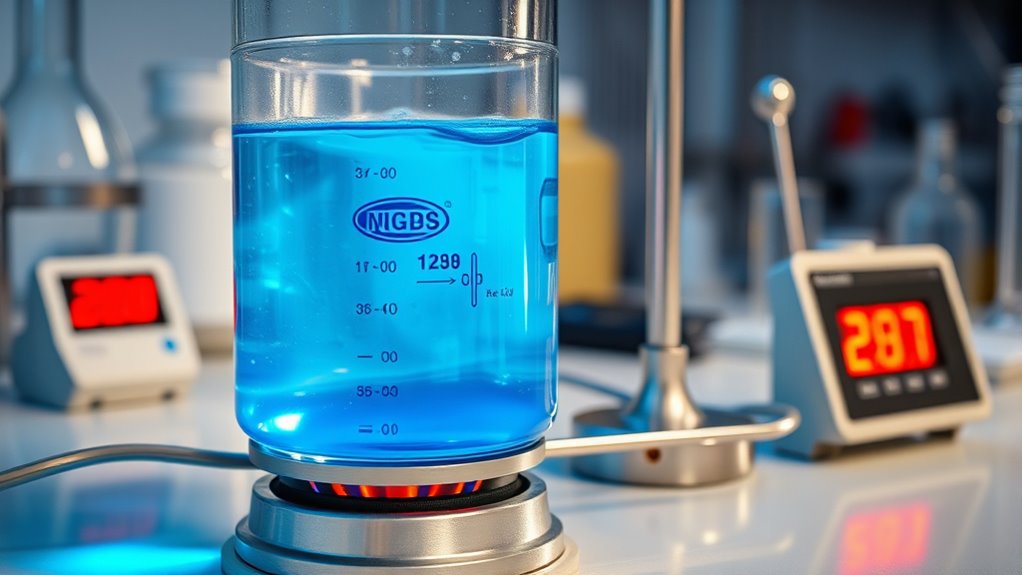
Temperature plays a crucial role in determining whether a chemical reaction is spontaneous by influencing Gibbs free energy. When temperature rises, it often favors spontaneity if the entropy change (ΔS) is positive, because it can lower ΔG.
The Gibbs-Helmholtz equation helps you understand this temperature dependence, showing how ΔG varies at different temperatures. If a reaction has a negative ΔS, increasing temperature makes it less favorable, raising ΔG.
Conversely, reactions with positive ΔS become more spontaneous as temperature increases. The equilibrium temperature is where ΔG equals zero, indicating a balance between forward and reverse reactions.
Keep in mind, these effects are especially noticeable when conditions deviate from standard temperature, like 25°C, affecting reaction spontaneity considerably.
The Connection Between Gibbs Free Energy and Chemical Equilibrium
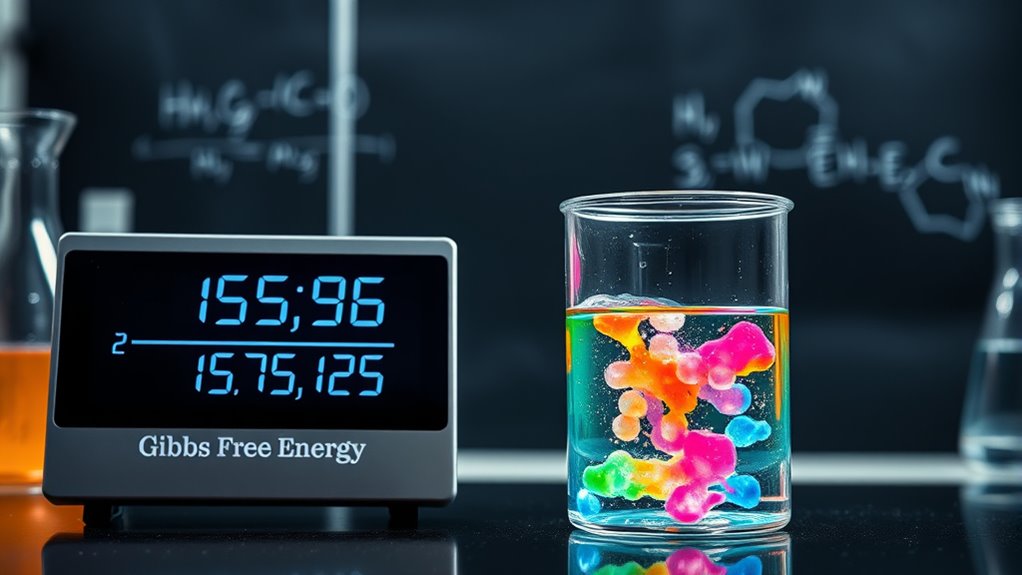
Gibbs free energy directly relates to the position of a reaction at equilibrium through the equilibrium constant (K). When ΔG° is negative, K is greater than 1, meaning the reaction favors product formation.
Conversely, if ΔG° is positive, K is less than 1, and reactants are favored. At equilibrium, ΔG equals zero, indicating no net change, and the system’s Gibbs free energy is minimized.
The reaction quotient (Q) measures the current ratio of products to reactants. If Q is less than K, ΔG is negative, and the reaction moves forward.
If Q is greater than K, ΔG is positive, and the reaction shifts backward. When Q equals K, ΔG is zero, and the system is at equilibrium, with no net change in composition.
Practical Uses of Gibbs Free Energy in Science and Industry
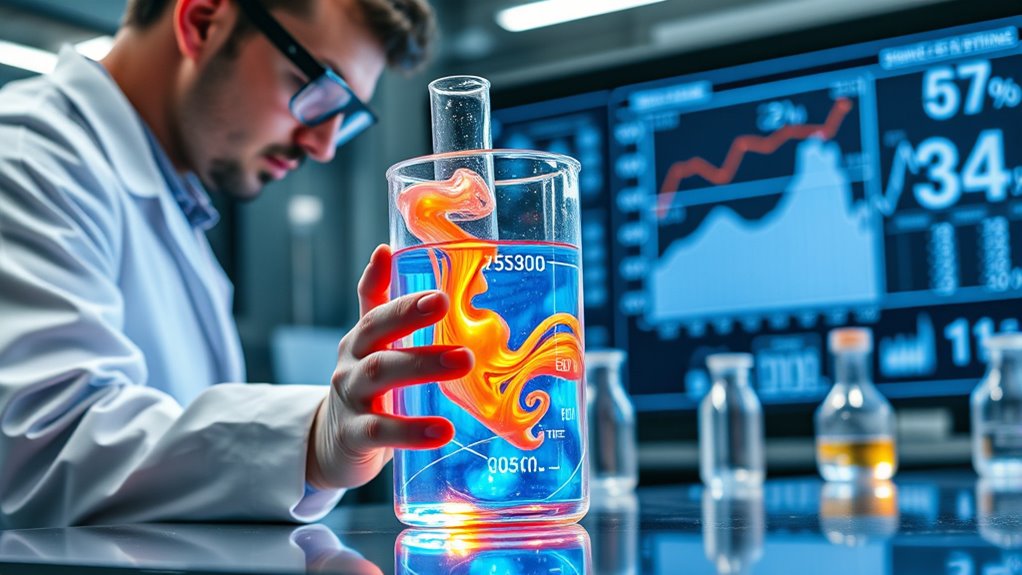
Practical uses of Gibbs free energy span various fields, guiding scientists and industry professionals in making informed decisions about chemical and physical processes.
In chemistry, it predicts whether reactions are spontaneous, helping to plan synthetic pathways and optimize material synthesis.
In industry, Gibbs free energy informs energy production, process efficiency, and material selection, reducing costs and waste.
It’s crucial in energy storage development, such as batteries and fuel cells, by predicting reaction feasibility.
In biochemical applications, it explains metabolic pathways, enzyme efficiency, and cellular energy flow.
Electrochemically, it aids in battery design, corrosion prevention, and electroplating processes.
Additionally, Gibbs free energy assists in designing lab experiments, teaching thermodynamics, and analyzing data, making it an essential tool for advancing scientific research and industrial innovation.
Visualizing Thermodynamics: The Historical Development of Gibbs’ Ideas
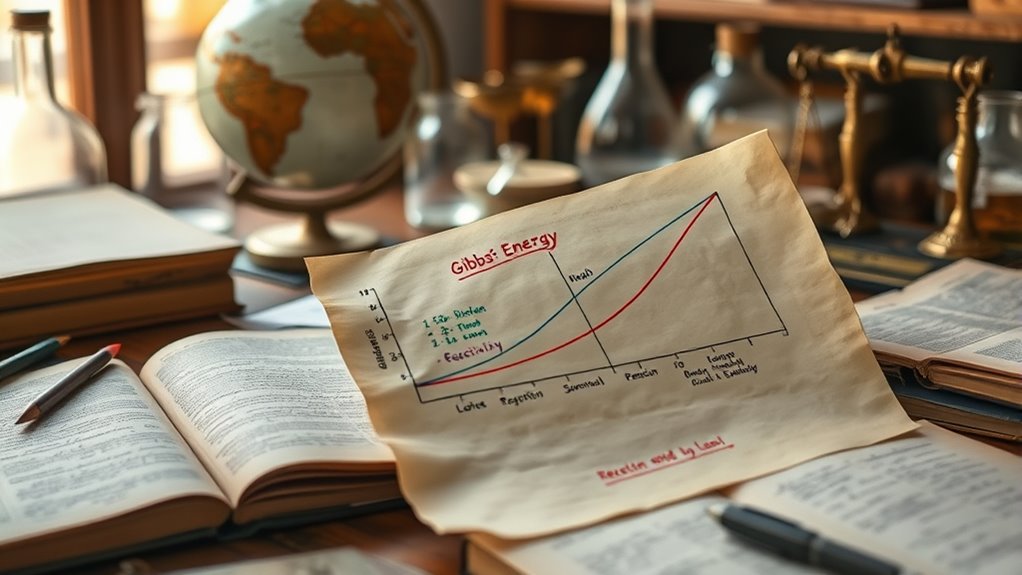
Understanding the development of thermodynamics becomes clearer when you explore how scientists visualized complex concepts. Gibbs revolutionized this by introducing graphical methods to represent thermodynamic properties.
In 1873, he published “Graphical Methods in the Thermodynamics of Fluids,” which used surfaces to visualize relationships between variables. His 1876 work created a three-dimensional graph of volume, entropy, and internal energy, allowing you to see equilibrium states—stable, neutral, or unstable—at a glance.
This visual approach made abstract ideas tangible, helping you understand how systems shift and reach equilibrium. Gibbs’ use of surfaces and geometrical models bridged theory with practical chemistry, enabling you to predict when reactions would occur spontaneously and how phases change.
These innovations laid the foundation for modern thermodynamics visualization.
Frequently Asked Questions
How Does Gibbs Free Energy Relate to Real-World Chemical Processes?
You’re wondering how Gibbs Free Energy relates to real-world chemical processes. It tells you whether a reaction will happen on its own or need extra energy.
Engineers and scientists use ΔG to optimize conditions, design catalysts, and improve efficiency in industries like energy, food, and manufacturing.
Can Gibbs Free Energy Predict Reaction Rates or Just Spontaneity?
You wonder if Gibbs free energy guides growth or governs speeds. The truth is, Gibbs free energy mainly measures whether a reaction’s spontaneous, not how quickly it happens.
You can have a reaction that’s energetically favorable but painfully slow without a catalyst. So, while ΔG determines direction and feasibility, it doesn’t predict pace—kinetics, not thermodynamics, controls reaction rates.
How Do Phase Changes Influence Gibbs Free Energy?
Phase changes impact Gibbs free energy by causing discontinuities or shifts in its value. When a phase shift occurs, the Gibbs energy of the new phase becomes lower, making it thermodynamically favored.
You’ll see this at melting or boiling points, where the Gibbs energy curves intersect. These changes often involve latent heat and abrupt slope shifts, reflecting the first-order nature of many phase transitions, driving the system toward equilibrium.
What Role Does Pressure Play in Determining Gibbs Free Energy?
Imagine you’re adjusting the volume on a speaker; pressure similarly influences Gibbs free energy. When you increase pressure, especially in gases, it can raise or lower the energy depending on the system’s volume.
You’ll see this in reactions where pressure shifts the balance, favoring the side with fewer gas moles. Fundamentally, pressure acts like a lever, tipping the energy scales and guiding reaction spontaneity and equilibrium.
Are There Limitations to Using Gibbs Free Energy for Complex Reactions?
You should recognize that Gibbs free energy has limitations with complex reactions. It predicts whether a reaction is spontaneous but doesn’t reveal the reaction pathway or intermediate steps.
Kinetic factors, temperature, pressure changes, and reaction mechanisms can all influence outcomes beyond what ΔG indicates.
Additionally, measuring accurate thermodynamic data is challenging, especially in multi-component systems, so relying solely on Gibbs energy may lead to incomplete or misleading predictions.
Conclusion
Understanding Gibbs free energy helps you predict whether a reaction will happen on its own, much like knowing if a ball will roll downhill. By grasping its concepts, you can make smarter decisions in chemistry and industry. Remember, even in the age of steam engines, Gibbs’ ideas were revolutionary—showing that energy and spontaneity always follow certain rules. So, keep these principles in mind, and you’ll navigate chemical reactions with the confidence of a seasoned scientist.
